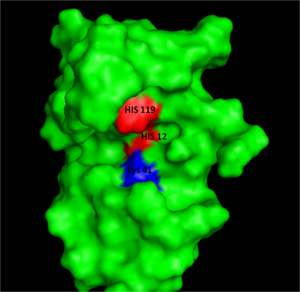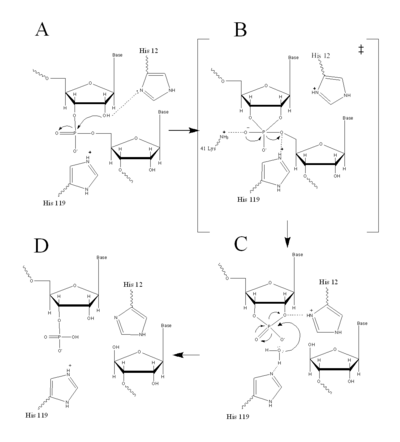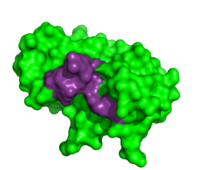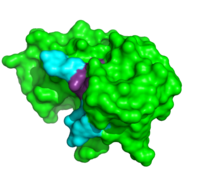RNase A
From Proteopedia
(Difference between revisions)
| Line 32: | Line 32: | ||
==='''Active Site Structure'''=== | ==='''Active Site Structure'''=== | ||
| - | [[Image:MechIII.png|400px|left|thumb|Figure II: RNase A Catalysis. (A) Initial attack of 2'hydroxyl stabilized by His12. (B) Pentavalent phosphorous intermediate. (C) 2'3' cyclic intermediate degradation. (D) Finished products: Two distinctive nucleotide sequences. Figure generated via ''Chemdraw'']] | + | [[Image:MechIII.png|400px|left|thumb|Figure II: RNase A Catalysis. (A) Initial attack of 2'hydroxyl stabilized by His12. (B) Pentavalent phosphorous intermediate. (C) 2'3' cyclic intermediate degradation. (D) Finished products: Two distinctive nucleotide sequences. Figure generated via ''Chemdraw'']] |
| + | {{Clear}} | ||
RNase A uses acid/base catlysis to speed up RNA hydrolysis. This occurs in the <scene name='Sandbox_Reserved_193/Active_site_a/1'>active site</scene> which is found in the cleft of RNase A and is the location of the chemical change in bound substrates. Subsites lining the active site cleft are important to the binding of single stranded RNA. Large quantities of positively charged residues, such as <scene name='Sandbox_Reserved_193/Lys7_arg10_arg39_lys41_lys66/1'>Lys7, Arg10, Arg39, and Lys41, and Lys66</scene>, recognize the negative charge on the phosphate back bone of the <scene name='Sandbox_Reserved_194/Positive_amino_acids_substrate/1'>RNA strand</scene> <ref name="Wlodrawer" />. | RNase A uses acid/base catlysis to speed up RNA hydrolysis. This occurs in the <scene name='Sandbox_Reserved_193/Active_site_a/1'>active site</scene> which is found in the cleft of RNase A and is the location of the chemical change in bound substrates. Subsites lining the active site cleft are important to the binding of single stranded RNA. Large quantities of positively charged residues, such as <scene name='Sandbox_Reserved_193/Lys7_arg10_arg39_lys41_lys66/1'>Lys7, Arg10, Arg39, and Lys41, and Lys66</scene>, recognize the negative charge on the phosphate back bone of the <scene name='Sandbox_Reserved_194/Positive_amino_acids_substrate/1'>RNA strand</scene> <ref name="Wlodrawer" />. | ||
| Line 55: | Line 56: | ||
[[Image:1RTAnew.png|thumb|left|200px|Thymidylic acid tetramer complexed with ribonuclease A]] | [[Image:1RTAnew.png|thumb|left|200px|Thymidylic acid tetramer complexed with ribonuclease A]] | ||
| - | + | {{Clear}} | |
To determine the structural characteristics of RNA substrate binding to RNase A, X-ray crystallography was used to image inhibitory DNA tetramers bound to RNase A. DNA lacks the 2’OH essential to RNA cleavage, making the complex more conducive to crystallography. <scene name='Sandbox_Reserved_194/1rta_structure/2' target='0'>The complex</scene> between RNase A and <scene name='Sandbox_Reserved_194/1rta_just_dt/2' target='0'>thymidylic acid tetramer (d(pT)4)</scene> ([[1rta]]) provides information about specificity of the binding pocket subunits, B0, B1, B2 and B3. Many interactions observed in this complex occur between amino acid residues and the nucleic acid backbone. Examples of these interactions include hydrogen bonding between <scene name='Sandbox_Reserved_194/1rta_structure_arg/5' target='0'> phosphate of T1 and Arg39</scene> as well as hydrogen bonding between the O5’ oxygen of the ribose of <scene name='Sandbox_Reserved_194/1rta_lys41/1' target='0'>T3 and Lys41</scene>. <ref>PMID:1429575</ref> | To determine the structural characteristics of RNA substrate binding to RNase A, X-ray crystallography was used to image inhibitory DNA tetramers bound to RNase A. DNA lacks the 2’OH essential to RNA cleavage, making the complex more conducive to crystallography. <scene name='Sandbox_Reserved_194/1rta_structure/2' target='0'>The complex</scene> between RNase A and <scene name='Sandbox_Reserved_194/1rta_just_dt/2' target='0'>thymidylic acid tetramer (d(pT)4)</scene> ([[1rta]]) provides information about specificity of the binding pocket subunits, B0, B1, B2 and B3. Many interactions observed in this complex occur between amino acid residues and the nucleic acid backbone. Examples of these interactions include hydrogen bonding between <scene name='Sandbox_Reserved_194/1rta_structure_arg/5' target='0'> phosphate of T1 and Arg39</scene> as well as hydrogen bonding between the O5’ oxygen of the ribose of <scene name='Sandbox_Reserved_194/1rta_lys41/1' target='0'>T3 and Lys41</scene>. <ref>PMID:1429575</ref> | ||
[[Image:1RCNnew.png|thumb|left|200px|ApTpApApG complexed with ribonuclease A]] | [[Image:1RCNnew.png|thumb|left|200px|ApTpApApG complexed with ribonuclease A]] | ||
| - | + | {{Clear}} | |
Further binding pocket characterization was performed using <scene name='Sandbox_Reserved_194/1rcn_structure/3' target='0'>RNase A complexed with the oligonucleotide d(ApTpApApG)</scene> ([[1rcn]]). This <scene name='Sandbox_Reserved_194/1rcn_just_dtda/3' target='0'>tetramer</scene> is closely positioned with the catalytic residues, <scene name='Sandbox_Reserved_194/1rcn_structure_active_site/1'>His12, Lys41, and His119</scene> and was important in determining the specificity of the binding sites of RNase A. In this complex, the B1 site is thought to exclusively bind to pyrimidine bases due to steric interactions and <scene name='Sandbox_Reserved_194/1rcn_thr45/1' target='0'>hydrogen bonding to Thr45d</scene>. When Thr45 was mutated to glycine, purines readily bound to the B1 site. <ref>PMID: 8193116</ref> This interaction appears to be the driving force behind its inability to bind purines. While binding of other nucleobases to the B2 and B3 sites is possible, the imaging of this complex elucidated the preferences for adenosine bases at these two positions. In addition to its catalytic activity His119 has also been shown to be important in substrate specificity. This is due to the <scene name='Sandbox_Reserved_194/1rcn_his/10' target='0'>pi stacking between His119 and A3 </scene>. When this site was mutated, the affinity for a poly(A) substrate was decreased by 104-fold. <ref>PMID: 21391696</ref> It also establishes hydrogen bonding between <scene name='Sandbox_Reserved_194/1rcn_hydrogen_bonding/10'>Asn71-A3, Gln69-A3 and Gln69-A4</scene>. <ref>PMID:8063789</ref> | Further binding pocket characterization was performed using <scene name='Sandbox_Reserved_194/1rcn_structure/3' target='0'>RNase A complexed with the oligonucleotide d(ApTpApApG)</scene> ([[1rcn]]). This <scene name='Sandbox_Reserved_194/1rcn_just_dtda/3' target='0'>tetramer</scene> is closely positioned with the catalytic residues, <scene name='Sandbox_Reserved_194/1rcn_structure_active_site/1'>His12, Lys41, and His119</scene> and was important in determining the specificity of the binding sites of RNase A. In this complex, the B1 site is thought to exclusively bind to pyrimidine bases due to steric interactions and <scene name='Sandbox_Reserved_194/1rcn_thr45/1' target='0'>hydrogen bonding to Thr45d</scene>. When Thr45 was mutated to glycine, purines readily bound to the B1 site. <ref>PMID: 8193116</ref> This interaction appears to be the driving force behind its inability to bind purines. While binding of other nucleobases to the B2 and B3 sites is possible, the imaging of this complex elucidated the preferences for adenosine bases at these two positions. In addition to its catalytic activity His119 has also been shown to be important in substrate specificity. This is due to the <scene name='Sandbox_Reserved_194/1rcn_his/10' target='0'>pi stacking between His119 and A3 </scene>. When this site was mutated, the affinity for a poly(A) substrate was decreased by 104-fold. <ref>PMID: 21391696</ref> It also establishes hydrogen bonding between <scene name='Sandbox_Reserved_194/1rcn_hydrogen_bonding/10'>Asn71-A3, Gln69-A3 and Gln69-A4</scene>. <ref>PMID:8063789</ref> | ||
Revision as of 09:36, 27 February 2019
This page, as it appeared on October 8, 2011, was featured in this article in the journal Biochemistry and Molecular Biology Education.
| |||||||||||
Additional Proteopedia Pages about RNase A
3D structures of ribonuclease
References
- ↑ 1.0 1.1 1.2 1.3 1.4 1.5 1.6 1.7 1.8 1.9 Raines RT. Ribonuclease A. Chem Rev. 1998 May 7;98(3):1045-1066. PMID:11848924
- ↑ Avey HP, Boles MO, Carlisle CH, Evans SA, Morris SJ, Palmer RA, Woolhouse BA, Shall S. Structure of ribonuclease. Nature. 1967 Feb 11;213(5076):557-62. PMID:6032249
- ↑ Wyckoff HW, Hardman KD, Allewell NM, Inagami T, Johnson LN, Richards FM. The structure of ribonuclease-S at 3.5 A resolution. J Biol Chem. 1967 Sep 10;242(17):3984-8. PMID:6037556
- ↑ Greenway MJ, Andersen PM, Russ C, Ennis S, Cashman S, Donaghy C, Patterson V, Swingler R, Kieran D, Prehn J, Morrison KE, Green A, Acharya KR, Brown RH Jr, Hardiman O. ANG mutations segregate with familial and 'sporadic' amyotrophic lateral sclerosis. Nat Genet. 2006 Apr;38(4):411-3. Epub 2006 Feb 26. PMID:16501576 doi:10.1038/ng1742
- ↑ 5.0 5.1 5.2 'Lehninger A., Nelson D.N, & Cox M.M. (2008) Lehninger Principles of Biochemistry. W. H. Freeman, fifth edition.'
- ↑ 6.0 6.1 6.2 Wlodawer A, Svensson LA, Sjolin L, Gilliland GL. Structure of phosphate-free ribonuclease A refined at 1.26 A. Biochemistry. 1988 Apr 19;27(8):2705-17. PMID:3401445
- ↑ Birdsall DL, McPherson A. Crystal structure disposition of thymidylic acid tetramer in complex with ribonuclease A. J Biol Chem. 1992 Nov 5;267(31):22230-6. PMID:1429575
- ↑ delCardayre SB, Raines RT. Structural determinants of enzymatic processivity. Biochemistry. 1994 May 24;33(20):6031-7. PMID:8193116
- ↑ Thompson JE, Raines RT. Value of general Acid-base catalysis to ribonuclease a. J Am Chem Soc. 1994 Jun;116(12):5467-8. PMID:21391696 doi:10.1021/ja00091a060
- ↑ Fontecilla-Camps JC, de Llorens R, le Du MH, Cuchillo CM. Crystal structure of ribonuclease A.d(ApTpApApG) complex. Direct evidence for extended substrate recognition. J Biol Chem. 1994 Aug 26;269(34):21526-31. PMID:8063789
- ↑ Kobe B, Deisenhofer J. A structural basis of the interactions between leucine-rich repeats and protein ligands. Nature. 1995 Mar 9;374(6518):183-6. PMID:7877692 doi:http://dx.doi.org/10.1038/374183a0
- ↑ Turcotte RF, Raines RT. Interaction of onconase with the human ribonuclease inhibitor protein. Biochem Biophys Res Commun. 2008 Dec 12;377(2):512-4. Epub 2008 Oct 16. PMID:18930025 doi:10.1016/j.bbrc.2008.10.032
External Resources
- Full crystal structure of 1RTA
- Full crystal structure of 1RCN
- Further information on 1RTA
- RNase A- Molecule of the Month
- RNase A-Wikipedia
- Ribonuclease Inhibitor-Wikipedia
- Ribonuclease-Wikipedia
- Ruminants-Wikipedia
Student Contributors
- Nathan Clarke and Kristyn Shaw
- Mary Andorfer, Grace Douglass, and Laurel Heckman
- Lauren Garnett and Micah Raebel
Proteopedia Page Contributors and Editors (what is this?)
Alexander Berchansky, R. Jeremy Johnson, Karsten Theis, Angel Herraez, Michal Harel




